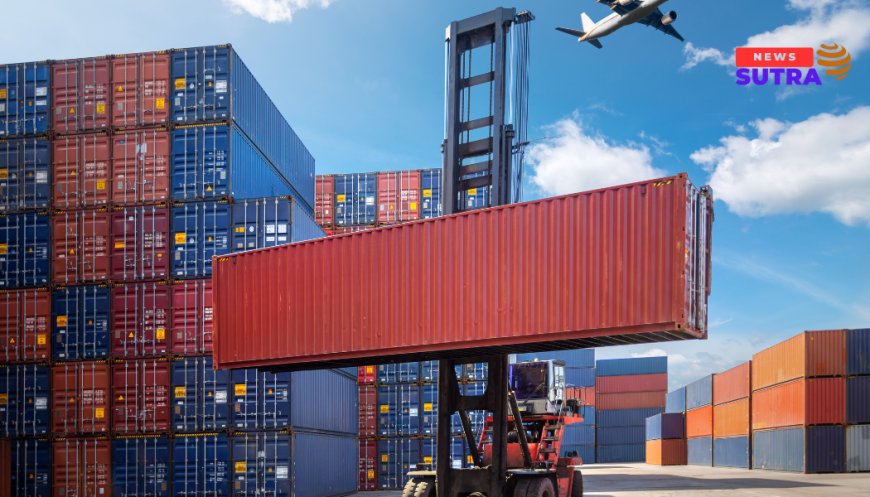India’s Export Ambitions in 2025: Can the Nation Rise as the Next Global Trade Powerhouse?
India’s export strategy in 2025 is focused on FTAs, logistics improvements, and manufacturing incentives. Can India position itself as a global trade giant amid shifting geopolitics?

India is at a defining moment in its economic journey. With geopolitical tensions reshaping global trade dynamics and manufacturers looking for alternatives to China, India’s export strategy in 2025 is under intense global scrutiny. The nation has set an ambitious target of reaching $1 trillion in goods and services exports by FY2030, with renewed focus on Free Trade Agreements (FTAs), improved logistics, and domestic manufacturing incentives.
In this in-depth article, we examine the key pillars of India’s export roadmap, major trade partners, policy reforms, and whether India truly has the capacity to become a global trade powerhouse.
Why 2025 Is a Crucial Year for Indian Exports
The global economic landscape in 2025 is marked by decoupling from China, a push for supply chain diversification, and increasing demand for green and digital goods. India, with its large workforce, robust digital infrastructure, and improving ease of doing business, is uniquely positioned to seize this opportunity.
According to the Ministry of Commerce and Industry, India’s merchandise exports touched $778 billion in FY2024, and service exports continue to rise, especially in IT, fintech, and healthcare.
Key Pillars of India’s Export Strategy in 2025
1. Free Trade Agreements (FTAs): Expanding Market Access
India has been aggressively negotiating and signing FTAs with key trade partners, aiming to provide preferential access to Indian goods in major global markets.
Recent Developments:
-
India-UAE CEPA and India-Australia ECTA have already boosted bilateral trade significantly.
-
Ongoing negotiations with the EU, UK, and GCC are expected to conclude soon, unlocking multi-billion-dollar export potential.
-
India is also exploring deeper engagement with ASEAN and Latin American markets.
📌 Refer to the DGFT Notifications for real-time FTA updates and tariff concessions.
2. Production-Linked Incentive (PLI) Schemes: Manufacturing for the World
The government’s PLI schemes, covering sectors like electronics, pharma, textiles, and semiconductors, are designed to boost exports by enhancing scale and competitiveness.
Sector Highlights:
-
Mobile exports hit a record $14 billion in FY24, led by Apple and Samsung’s manufacturing in India.
-
Pharma exports are set to surge with rising demand from Africa, the Middle East, and Latin America.
📌 DPIIT oversees several PLI schemes and provides data on performance-linked disbursals.
3. Modernizing Logistics and Ports Infrastructure
India's logistics cost remains high—around 13-14% of GDP—compared to 8% in developed nations. The PM GatiShakti National Master Plan aims to address this gap through multimodal connectivity.
Key Initiatives:
-
Development of Dedicated Freight Corridors (DFCs) to cut delivery timelines
-
Port modernization under the Sagarmala Project
-
Expansion of inland waterways and digital tracking systems
📌 Learn more on the GatiShakti portal, which maps critical infrastructure projects.
4. Trade Facilitation and E-Governance
The digitization of customs and port clearances has enhanced export processing speed. India's ranking in the World Bank's Logistics Performance Index is improving steadily due to initiatives like:
-
ICEGATE platform for seamless customs clearance
-
TMA (Transport and Marketing Assistance) for agri and food exports
-
Introduction of paperless EXIM trade ecosystems
📌 Visit ICEGATE to track customs modernization and exporter incentives.
5. Focus on Sunrise Sectors
India is not just exporting traditional goods like textiles and gems anymore. The new focus includes:
-
Green hydrogen and renewable tech components
-
Electric vehicles (EVs) and battery tech
-
AI-driven software services and cloud platforms
-
Ayush products and nutraceuticals in health and wellness
📌 Explore export opportunities in green sectors via the MNRE and Invest India.
Sector-Wise Export Outlook for 2025
| Sector | FY24 Export Value (Approx) | 2025 Outlook |
|---|---|---|
| Engineering Goods | $112 billion | Expected surge in auto components |
| Textiles & Apparel | $37 billion | Focus on MMF and technical textiles |
| Electronics | $23 billion | Growth via mobile & chip exports |
| Pharma & Healthcare | $27 billion | Rising demand from Africa, Latin America |
| IT & Software Services | $158 billion | Cloud, AI, cybersecurity-led growth |
| Agricultural Products | $50 billion | Boost via organic, processed exports |
📌 See Export Promotion Councils Directory to identify sector-specific policy updates and exporters’ support.
Challenges That India Must Overcome
While the momentum is strong, India faces certain headwinds:
-
High logistics costs and bureaucratic red tape
-
Non-tariff barriers in developed markets
-
Low R&D spend compared to global exporters
-
Limited product diversification in many sectors
Addressing these through sustained reforms and export skilling programs will be critical for long-term success.
What Global Trade Analysts Are Saying
According to a recent UNCTAD report, India is likely to become one of the top three contributors to global trade growth over the next five years. The country's services exports and value-added manufacturing are being watched closely by multilateral agencies and trade blocs alike.
Global analysts have also noted India's “China+1” advantage due to stable democratic governance, IP protection, and improving infrastructure.
Conclusion: Can India Become a Global Trade Giant?
India’s 2025 export strategy reflects a blend of ambition, realism, and geopolitical timing. With the right policy execution and support for exporters, India could emerge not just as a regional powerhouse but a central node in the global supply chain.
However, becoming a global trade giant will demand more than just incentives. It requires logistics efficiency, innovation-led production, trade diplomacy, and resilience to global market shifts. If these align, India’s export story could be one of the most transformative economic shifts of this decade.
What's Your Reaction?
 Like
0
Like
0
 Dislike
0
Dislike
0
 Love
0
Love
0
 Funny
0
Funny
0
 Angry
0
Angry
0
 Sad
0
Sad
0
 Wow
0
Wow
0







































































